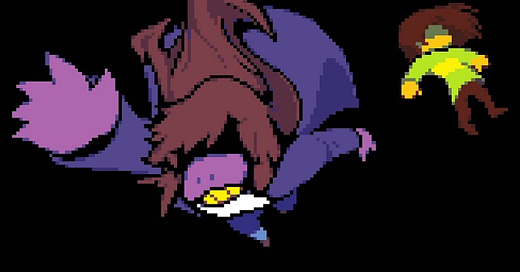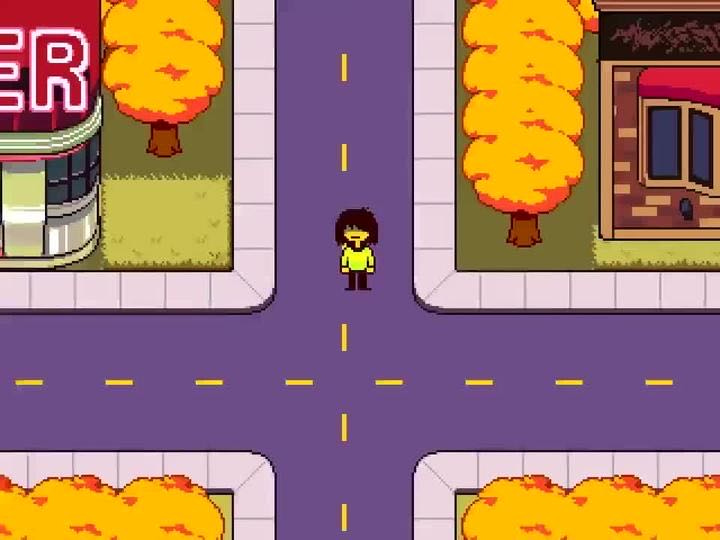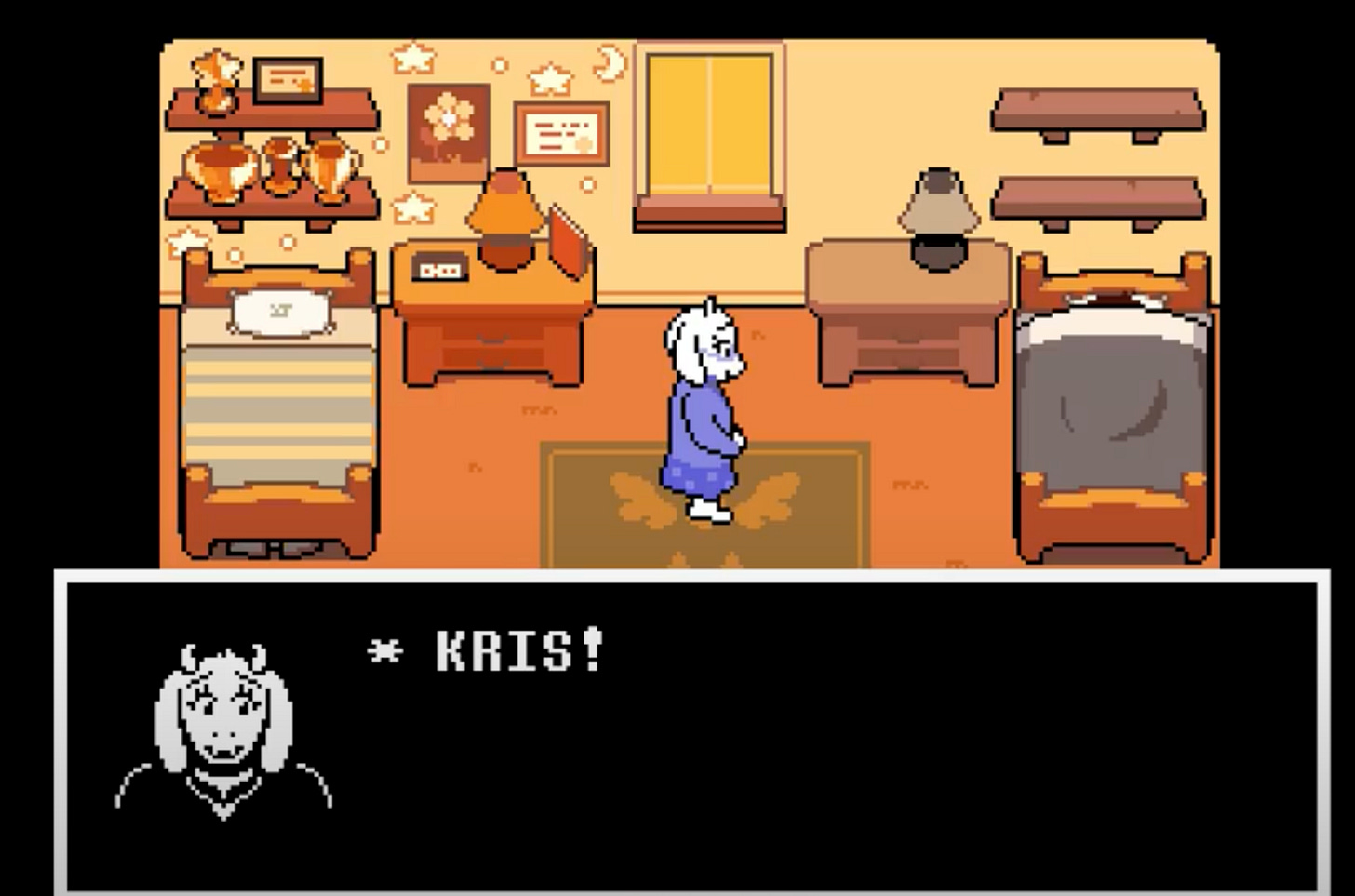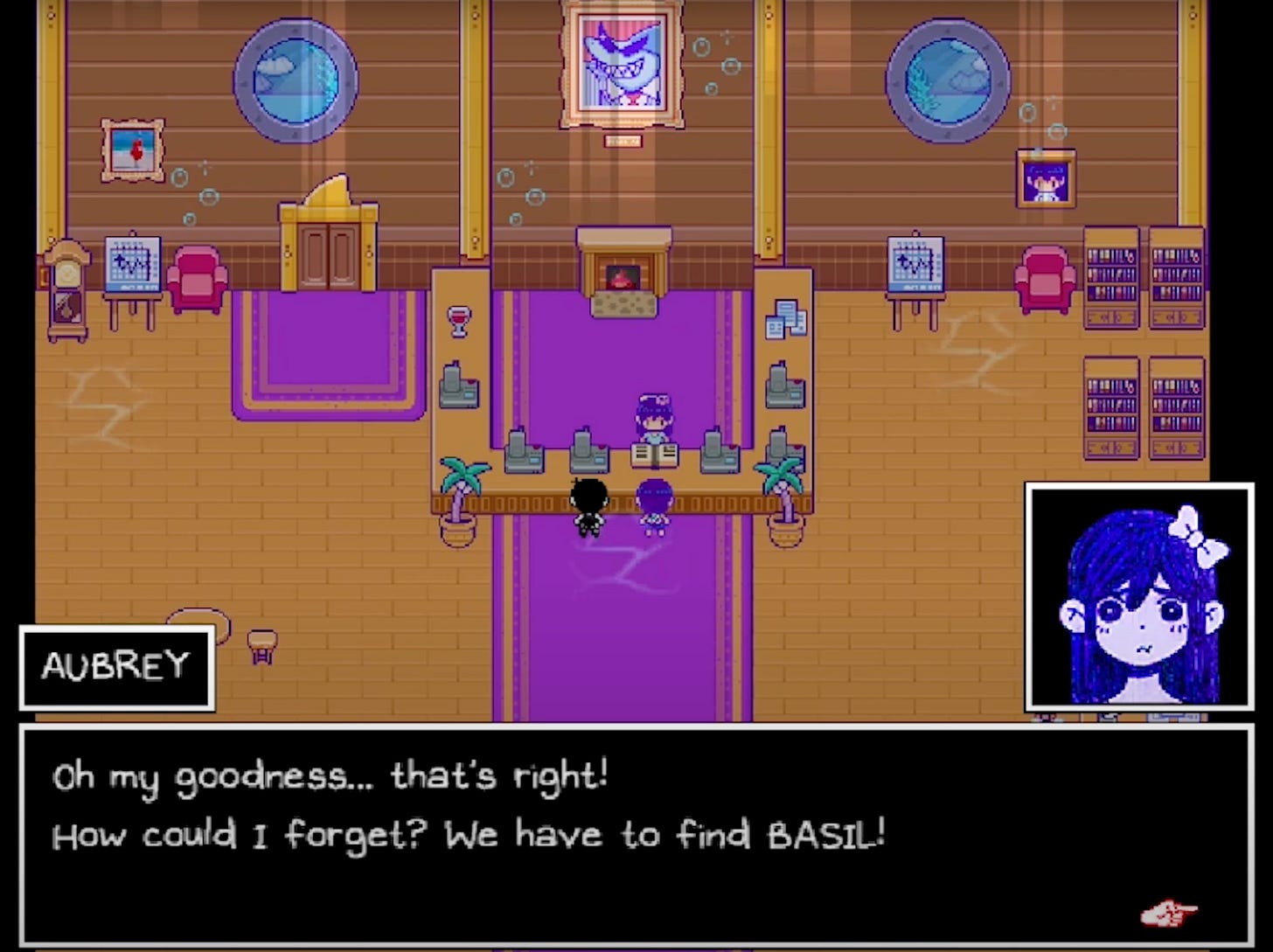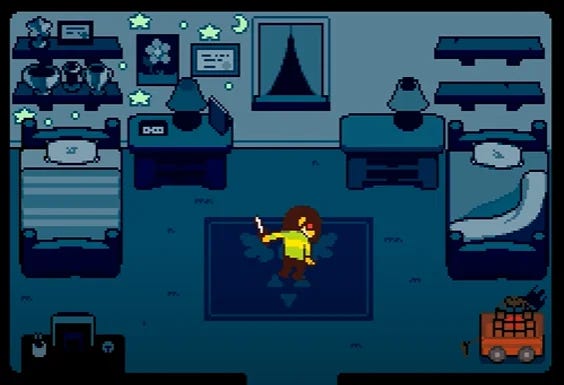OMORI, Deltarune and Escapism
Massive SPOILER ALERT for anyone who hasn’t played deltarune and OMORI. Seriously, if you haven’t played these games (especially OMORI), you really ought to shut off your computer and pick up the controller this instant.
Anyone who has played both OMORI and deltarune or its even more popular antecedent UNDERTALE,1 will have noticed certain superficial similarities between the two. They’re both inspired by Nintendo’s Earthbound from 1994, directed by the great Shigesato Itoi, adopting many of the same stylistic and thematic choices, perhaps the most obvious example being the pixelated quasi-3D design. But as it happens, there are actually some much more extensive parallels between these two games than one might think upon playing them for the first time. And as you might expect considering what Substack you’re reading, these parallels don’t just involve surface-level quirks like sprite design. No. Although the emotional tone of the games may be quite different all things considered, OMORI taking on a much darker and more psychologically chthonic character while deltarune so far remans mostly happy-go-lucky, both these games are deeply rooted in a one particular theme: escapism; the universal human tendency to attempt to run or hide from that which one fears or feels one cannot endure. And that parallel is what I want to explore with you today.
OMORI is probably my favourite game of all time. I find it doubtful to even call it a game. It’s more like a piece of art; like a modern Goethe’s Faust, and even then: as far as artworks go, OMORI most assuredly deserves to be mounted on a wall in a museum.2 OMORI is a game which transports you down into the deepest abyss of the human soul; a veritable journey into the belly of the beast and out through the other side again with a vengeance. It’s a story of grief and fragmentation; of repression and self-loathing, but also, hopefully: reconciliation and redemption - the coming to terms with one’s greatest mistakes and finding a way to live with them again. In this story, we follow Sunny: a 16 year old boy who has lived the last three and a half years holed up in his room in self-imposed isolation as a Hikikomori after making the mistake of his lifetime. Even with the spoiler warning, I won’t repeat the infamous Truth about what Sunny did, but needless to say, it was a personal tragedy of the greatest proportions, caused by a momentary lapse in judgment motivated by anger and reinforced by a conspiratorial set of circumstances leading to the worst outcome possible. It is that outcome and the choices made in the immediate aftermath which haunts our main protagonist Sunny for the entirety of the game, causing him to seek refuge in the imagined world of Headspace, created by his subconscious to provide a distraction from the intolerable reality, where he can live in a fabricated reality inspired by the blissfulness of his childhood. He escapes into his own dreams, his subconscious feeding him a version of the happy past which has been altered just enough to prevent it from causing his memory of the tragedy inevitably spring back into consciousness. And it’s this aspect; this hiding oneself away in a “dream-world” and taking refuge from reality which I want to focus on here.
While Sunny escapes into his own Headspace in order to get away from a downright intolerable reality, deltarune isn’t quite so extreme, yet it still ultimately rests on the same foundations. Whereas OMORI begins in this false Headspace and skips back and forth between it and the real-world, in deltarune, we as Kris: the main character who, like Sunny and UNDERTALE’s Frisk, is also a silent protagonist, start out in a ‘real’ world, seemingly much like our own.3 It’s a world of schoolchildren, policemen and divorced parents living in the “small town called Hometown”: a suburban native place many people could easily compare to the site of their own childhoods.4
It’s implied that Kris misses their5 older brother Asriel; and that in this way they too might be somehow unsatisfied with their everyday life. They meet Susie: the class bully, who herself must clearly suffer or have suffered a dismal family life which she now takes out on her classmates. That is, until the two of them by happenstance accidentally stumble their way into a hidden reality, discovering a dark world concealed and contained within the confines of a closet. At first, Susie seeks to find a way to escape, but by the time the two of them return at the end of the first chapter, she too finds herself aching to get back the next day. As she says: “Like I could sleep after yesterday!? Just waiting for today felt like… years!!”
Like Narnia, it’s motivically very much the story of schoolchildren seeking an escape from the monotony of everyday life in an alternate reality hidden in plain sight.
Just as OMORI’s Headspace is a complex amalgamation created from conjoined fragments of Sunny’s imagination, the dark worlds are likewise ‘constructed’ from parts of the real world. Each character present corresponds to an inanimate object in the real-world, like Lancer, who in the Light world exists as nothing more than a simple playing card. Stylistically and motivically they’re both very similar in this way; they’re both worlds of play which stand in contrast to a much more ordinary and benign reality, and which is somehow a reflection of that reality; somehow derived from it in the same way that an imaginary world is derived from things we’ve seen in reality. The game-like character of these alternate worlds is also presented in a similar way. In deltarune, there are many examples of characters which seem to be aware of the fact that their world is governed by game-like rules and structures like how buttons can be pressed to incite various actions and events, and how there exists such a thing as an “inventory.”
The dark worlds consistently follow this self-consciously game-like structure, with characters taking on typical, caricatured roles, Lancer initially wanting to be “the Bad Guy,” and Ralsei being the prince whose only purpose was stated explicitly to be to wait for the pre-destined heroes to arrive so that he could serve as their guide; their ‘tutorial-tutor’ in typical game-like fashion. It’s as though everything has been put together intentionally in such a way that the heroes will have something to do: a well-defined adventure to go on. So far it seems the pattern in each chapter is that the mysterious Knight opens a Dark Fountain, the heroes must go on an adventure, defeat the big baddie on the way and then return to the Light World to await the next adventure during the night. In this way, the stories of deltarune’s Dark Worlds are just as scripted and self-contained as in any game. But at the same time, we can’t avoid being reminded at times that there’s something fishy about deltarune. For instance, at the beginning of the game, it initially appears that we have the choice to create the main character for ourselves. A complete character creation sequence, complete with naming and all, is performed according to the instructions of a mysterious voice…
But then, poof. With the memorable line “Nobody can choose who they are in this world,” our new character is cast aside and we suddenly wake up.
Apparently we don’t have any choice after all, and must instead play as Kris: a character with a pre-defined name, appearance and personality. Thereafter, nothing whatever is said or done about the “vessel” we initially created, and the mysterious voice has yet to be heard from again. Besides this there are many other unresolved questions which hint at the untold depths to be explored in later chapters. Who, and where, is the knight? What is the Angel’s Heaven mentioned so haphazardly in Ralsei’s prophecy,6 and how is the mysterious Gaster involved? In other words: what’s the secret story beneath the surface? There’s a simple narrative going on within the context of the game world, but it seems like there’s something much more serious beneath it…
You may see where I’m going with this. In OMORI, Headspace is even more distinctly a superficial place in which more or less superficial events take place, which nonetheless conceal something far darker beneath the surface. The overall plot goal within Headspace is for Sunny and his imaginary friends to find their lost friend Basil,7 who disappeared at the beginning of the story. While engaged in this search, Sunny’s dream-avatar Omori and the rest of the gang encounter all sorts distractions, ranging from the banal to the outright glamorous, from helping Space Boyfriend find his lost VHS-tape, to escaping Sweetheart’s castle, to exploring the Last Resort, and on and on. And as these distractions mount, the original search for Basil becomes increasingly obscured, until Omori’s friends eventually forget what was the original goal of their quest.8
The true purpose of their search is constantly being pushed into the background as new and interesting side quests pop up like moles to be whacked. Yet every now and then hints pointing towards the Truth inevitably resurface, as we see at the end of each “Day” in the game: each Act. At the end of each day, after Sunny has woken up from his frivolous quest in Headspace and (hopefully) reconnected with his friends in the real-world, he then, before going to sleep, has to face one of his three fears: spiders, water and heights / darkness. The way this mechanic is structured is very similar to deltarune. So far, at the end of each chapter, when the day’s Dark Fountain has been closed and we’ve returned to the Light World to talk to its various characters, a darker side to Kris is at the very end displayed as they rip out their soul, the playful atmosphere of the game instantly giving way to a much more menacing tone right before the chapter ends. It’s as though Kris’ soul is something quite distinct from them; something alien and foreign,9 although the imagery around Kris themselves doesn’t make them look much better.
In other words, there’s something sinister; a can of worms, in both games, which remains unresolved throughout the light-hearted endeavours of Headspace and the Dark Worlds. At the end of each day, someone sticks a hole in the can and a single worm comes out, but we all know that the entire thing has to be opened some point. The way this whole structure works in deltarune is strikingly similar to to OMORI, not least when we consider that just like OMORI’s three acts are organised as three Days, each of deltarune’s chapters also all takes up the space of one day, starting with a quest in one of the Dark Worlds which fills our minds with distraction and noise, and ending with a stroll around town in the Light World before concluding with a sinister cliffhanger. Thus we see that the narrative structures of the two games are incredibly similar in many ways, not just on zoomed-out level of vaguely defined themes, but also at the level of each act’s specific template. With all this under consideration, before we conclude I think it’s apt to mention that Toby Fox himself, all the way back in 2014, stated the following:
This tweet lines up very well with OMORI’s initial development, as it was in 2014 that it was initially announced, having existed as a concept for a couple years before that. Toby also made a music track for OMORI, and Omocat created some of the art for UNDERTALE. With all this in mind I think we’d be safe to assume OMORI was the game referred to in the tweet, and with the parallels thus far explored, it’s easy to see why Toby might be alarmed. In the end, he managed to make it different enough that those initial similarities are now somewhat hard to spot, but when looking at the deeper themes of both games we recognise that their resemblance goes beyond the shared inspiration taken from Earthbound. It’s possible to say that both games are fundamentally about escapism, and furthermore: the gradual process of slowly seeing through superficial appearances in order to get at an underlying reality which holds greater meaning than the superficial one. They’re about the temporary blissfulness of immersing oneself in a frivolous world of entertainment which will nonetheless eventually have to be transcended. While OMORI’s Headspace is clearly a “fake” world of dreams created to entertain Sunny while he rests in repression, deltarune’s Dark World may be real in a more significant way, in the same way that Narnia is more real than a dream. But despite this, just like Headspace, it’s nonetheless ultimately hiding a deeper layer whose gravity and relevance to us as players is of a whole other magnitude, the full unraveling of which will completely shift the context and depth of the game when it’s eventually completed. Until then, let’s keep exploring along the way and let time tell whether the two games ultimately converge completely upstream, or go their separate ways. Thanks for reading.
In fact, I loved this game so much the I spent at least a hundred hours making this YouTube-series on it, so if you want to see just how deep this game goes, check it out here.
Relatively speaking… I mean, it’s also full of monsters, Kris being the only human. But the overall character of this world is nonetheless similar to that of the real world.
Incidentally, it’s also strikingly similar to Faraway Town; the setting of OMORI’s corresponding ‘real world.’ Both are small suburbs or villages with a homely atmosphere which can be explored freely during specific parts of the game. More on this later.
Kris’ gender, like their cosmic twin Frisk’s, is unspecified.
Watch my latest video for more on this:
Basil is also the other person with the closest possible connection to and involvement in the aforementioned tragedy besides Sunny himself. As such, the disappearance of Basil corresponds psychologically to the repression of a content which threatens to boil the Truth back to the surface of Sunny’s mind.
This isn’t just the characters forgetting. Psychologically, since Headspace exists in Sunny’s mind, it corresponds to Sunny’s subconscious efforts to repress everything that has to do with the Truth whenever it threatens to get too close to re-emerging. Everything that happens in Headspace must be taken in a psychodynamic context.
In all probability the player themselves.

